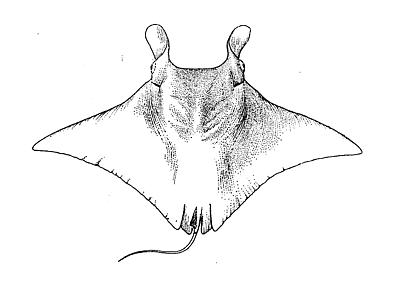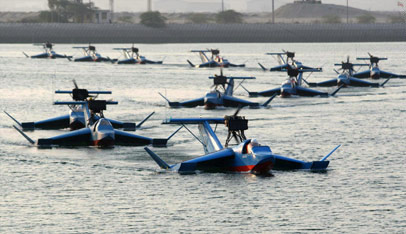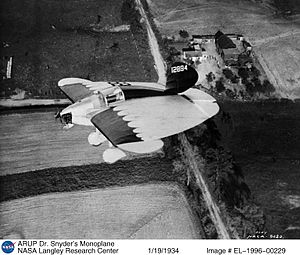There is info about straight edge wings, swept back wings, swept forward wings, delta wings. Is there also info about a Delta wing with a straight leading edge and a tapered trailing edge, the point rearwards, like a manta ray?
4 Answers
To answer your second question first: Yes, these are mainly used for ground-effect craft. The idea is to have positive angle of attack, a tapered wing and a trailing edge with constant, low distance from the ground. This question covers their sweep angle.

The RFB X-114 ground-effect craft. Forward is right.
The wing would behave just like an ordinary, forward swept, low aspect ratio wing. It would have a small lift curve slope and a lousy stall behavior, because the low tip chord will make the tips stall first, causing the whole wing to roll. Unfortunately, the low leading edge sweep will prevent vortex lift, which is a typical feature of regular delta wings, to develop, so the stall angle will be only little higher than that of a straight wing with the same aspect ratio.

Manta rays are more diamond-shaped, so their "wing" has positive leading edge sweep and almost zero quarter-chord sweep. Their stall behavior would also be nasty if they were rigid, but the wings are actually fins and used for propulsion, not lift, so stall does not mean that the fish plunges to the ground. The picture above shows an Atlantic manta and was shamelessly copied from Wikipedia.
-
3$\begingroup$ If the manta ray wing stalls, he plunges... millimeters deeper into the water. ;) $\endgroup$– FreeManCommented Jan 20, 2015 at 20:07
-
1$\begingroup$ Wow, it took me a few minutes to figure out what I was looking at and from what angle, re the first picture. $\endgroup$ Commented Jan 20, 2015 at 20:29
-
8$\begingroup$ Note that manta rays (or any other rays) don't have swim bladders so they do rely on hydrodynamic lift for depth control. But they only need a little bit of it and with dynamic pressure in water they don't need much speed to get it. $\endgroup$ Commented Jan 20, 2015 at 22:36
-
$\begingroup$ The X-114 is one of my favorite designs, for some reason. $\endgroup$– egidCommented Jun 5, 2015 at 2:20
-
$\begingroup$ Responses are good and detailed, but the Arup, Hoffman, Milt's Little Bird and Flying Pancake tailess airplanes all had this type of straight leading edge, and something like an inverted delta trailing side of wing, but were not ground effect machines as the Lippisch aerodynes. Any specific experiences or info about these low Reynolds number, low aspect ratio aircraft? Regards, Salut + $\endgroup$– UrquiolaCommented Sep 5, 2017 at 8:24
See also the '30s Arup planes, from Indiana. Straight LE, and semi-circular TE. A low aspect-ratio lifting body that did not suffer from high parasitic drag due to wing-tip vortexes, and were slippery and quick with very low landing speeds. Hatfield in the '80s followed them with his "little Bird" series which flew much the same. The '40s Eschelman diamond shaped "flying flounder" was another
The reverse delta wing configuration, which Dr. A. Lippisch proved to be very stable in ground effect, creates a very steady position of the Cm (pitching moment) when the wing is close to a surface.
-
$\begingroup$ I just realized the Peter Girard Delta shaped RotorWing F-104 VTOL considered at Ryan, could have also be flown with the rotor having an straight leading edge, but it seems never went beyond mockup stage. Thanks. Salut + $\endgroup$– UrquiolaCommented Oct 22, 2019 at 15:01
-
$\begingroup$ This report, silent, German text, about development of Alexander Lippisch X-113 Ground Effect machine, also able to free flying, answers a lot of question. youtu.be/gnflnBF7jWk Patent US3190582, 1965, describes this Aerofoil Boat. Blessings + $\endgroup$– UrquiolaCommented Jan 5, 2022 at 13:05
-
$\begingroup$ link.springer.com/chapter/10.1007/978-3-319-02836-1_7 $\endgroup$– UrquiolaCommented Apr 14, 2022 at 13:31
-
$\begingroup$ References, from an article by Stuart Urquhart, and other by Afaq Altaf: -Lippisch, A. M., "Ground Effects Utilizing and Transition Aircraft," U.S. Patent US3190582A, filed 1965; Gerhardt, H. A., "Supersonic Natural Laminar Flow Wing," Patent US005538201A, filed 1996; Mou, H., "An Experimental Investigation of the Passive Control of Reverse Delta Wing Vortex Flow Structure and Aerodynamic Characteristics," Master's Thesis, McGill Univ., Montreal, 2015; Ko, L. S., "An Experimental Investigation of the Aerodynamics and Vortex Flowfield of a Reverse Delta Wing," Ph.D. McGill Uni, Montreal, 2016. $\endgroup$– UrquiolaCommented Apr 22, 2022 at 16:04
-
$\begingroup$ 'The trailing vortices generated by a reverse delta wing with different wing configurations', T Lee, SM He. Aerospace Science and Technology. 2018; -'Study of the reverse delta wing', Afaq Altaf et al, Journal of Aircraft, Jan 2011; 'Aircraft', RJ Thompson, Patents US2167143; US2303713. Blessings + $\endgroup$– UrquiolaCommented Apr 22, 2022 at 16:11
 : Besides book on Aerodynamics of Alexander Lippisch unconventional machines, see A Lippisch Wikipedia article, and patent US3190582, attached please find images of an Iranian Sea Patrol WIG and improvements in basic A Lippisch X-112 design to reduce drag [
: Besides book on Aerodynamics of Alexander Lippisch unconventional machines, see A Lippisch Wikipedia article, and patent US3190582, attached please find images of an Iranian Sea Patrol WIG and improvements in basic A Lippisch X-112 design to reduce drag [ Blessings +
Blessings +
-
$\begingroup$ From the plan-view's (less from the photo), it looks like they were taking inspiration in the design from the Klingon warships of Star Trek! $\endgroup$– Ralph J ♦Commented Sep 4, 2023 at 13:53
-
$\begingroup$ No 'Star Wars' machine, it's an Alexander Lippisch design, X-112 and X-113, patent US3190582, see videos: youtu.be/LMZIriem-xw?si=BMqoSnREf3D3Tnt8 youtu.be/gnflnBF7jWk?si=cc0gMULqPe-6qyrd Blessings + $\endgroup$– UrquiolaCommented Sep 7, 2023 at 8:16

